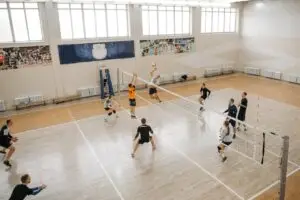Volleyball is a dynamic and exciting sport that requires coordination, skill, and teamwork. One of the key positions on the team is the setter.
The setter is responsible for coordinating the team’s offense, ensuring that the spikers have the opportunity to kill the ball, and making quick decisions to set up scoring opportunities.

In volleyball, the setter is allowed to move before the serve, strategically positioning themselves to receive the first pass and initiate the team’s offensive play.
This movement is a fundamental aspect of the setter’s role, allowing them to anticipate the play, communicate with teammates, and make quick decisions.
The setter is widely regarded as the hardest position in volleyball due to the responsibility that comes with coordinating the team’s offense.
Key Takeaways
- The setter is responsible for coordinating the team’s offense and ensuring that the spikers have the opportunity to kill the ball.
- The setter is allowed to move before the serve, strategically positioning themselves to receive the first pass and initiate the team’s offensive play.
- The setter is widely regarded as the hardest position in volleyball due to the responsibility that comes with coordinating the team’s offense.

What Does a Setter Do in Volleyball
In volleyball, the setter is a crucial player who orchestrates the team’s offense. It’s primary role is to receive the first ball and set it up for their teammates.
They are responsible for delivering accurate and consistent sets to their hitters, which requires excellent hand-eye coordination, touch, and precision.
He is also responsible for making strategic decisions during the game and adjusting the team’s offense based on the opponent’s defense.
They must be able to read the game and anticipate the opponent’s movements to make the best decisions for their team.
Setter Positioning on the Court
The setter’s positioning on the court is critical to their success. The setter’s base position is between positions 2 and 3, which is the location on the court from which they’ll look to set balls from.
When in the backcourt, they’ll defend from position 1, and in the front court, they’ll block in position 2.
Required Skills and Techniques For a Setter

Setting Techniques
A setter in volleyball must have excellent setting techniques to ensure accurate and consistent sets for their teammates. This includes proper hand positioning, footwork, and body positioning.
Setters must have ball control and accurate setting, which requires a lot of practice and repetition.
They must also be able to set the ball in a variety of ways, including back sets, quick sets, and jump sets.
Strategic Decision Making
In addition to setting the ball, setters must also make strategic decisions on the court. This involves reading the opposing team’s defense, predicting their movements, and calling plays accordingly.
An outstanding setter is the cornerstone of a team’s offense, requiring technical skills and the ability to lead and strategize.
A great setter should be able to make quick decisions and adjust their plays on the fly.
Communication and Leadership
A setter must also possess strong communication and leadership skills. They must be able to effectively communicate with their teammates, providing direction and feedback.
Setters are often the team’s “quarterback,” leading the offense and directing the flow of the game.
They must be able to motivate their teammates and keep them focused on the game.
How to Become a Better Setter

Drills for Improving Setting
To become an effective volleyball setter, rigorous training and practice are essential. There are several drills that can help improve setting skills.
One drill is to practice setting to a target. This can be done by setting to a specific spot on the wall or using a target net. Another drill is to practice setting with one hand.
This helps develop hand-eye coordination and improves the ability to set from any position.
Physical Conditioning
Physical conditioning is also important for setters. A strong core and upper body are essential for setting. Setters should focus on exercises that improve their balance, stability, and agility.
Plyometric exercises, such as jumping drills, can help improve explosive power. Additionally, speed ladder exercises can help improve footwork and overall quickness.
Overall, becoming an effective setter requires dedication and hard work. By incorporating these drills and exercises into their training regimen, setters can improve their skills and take their game to the next level.
Setter Rules and Regulations

Setter-Specific Rules
In volleyball, the setter is a crucial position responsible for coordinating the team’s offense. As a result, there are specific rules and regulations that setters must follow to ensure fair play and a level playing field.
One of the most important rules for setters is that they are only allowed to touch the ball with their fingertips when setting.
This rule is in place to prevent players from carrying or throwing the ball, which would give them an unfair advantage.
Setters must also ensure that they only touch the ball once when setting, as touching the ball twice in a row is considered a double contact and results in a point for the opposing team.
Another important rule for setters is that they must be in the front row of the court when setting. This is because when a setter is in the back row, they are not allowed to jump and attack the ball, as this would be considered an illegal back-row attack.
Setters must also adhere to the same rules as other players when it comes to serving, blocking, and hitting.
For example, when serving, setters must stay behind the end line until after they have made contact with the ball.
When blocking, setters must jump and reach over the net to block the ball, but they are not allowed to touch the net with any part of their body.
Frequently Asked Questions

What are the primary responsibilities of a setter in a volleyball team?
The primary responsibility of a setter in a volleyball team is to orchestrate the team’s offense by setting up the ball for their teammates to hit over the net. They must have excellent hand-eye coordination, quick reflexes, and the ability to make split-second decisions.
How does the role of a setter differ from other volleyball positions?
Unlike other positions in volleyball, such as outside hitters or middle blockers, the setter is responsible for the team’s overall strategy and playmaking. They must be able to read the opposing team’s defense and make quick decisions about where to set the ball.
Why is the setter position considered crucial in a volleyball match?
The setter position is considered crucial in a volleyball match because they are responsible for setting up the team’s offense. A good setter can make the difference between a successful attack and a missed opportunity. They must be able to work well with their teammates and have excellent communication skills.
What are the unique skills a setter must have to excel in volleyball?
A setter must have excellent hand-eye coordination, quick reflexes, and the ability to make split-second decisions. They must also have good communication skills and be able to work well with their teammates. Additionally, a setter must have a strong understanding of the game and be able to read the opposing team’s defense.
Can you describe the different strategic plays a setter can execute?
There are several different strategic plays that a setter can execute, including the quick set, the back set, and the dump. The quick set is a fast attack in which the ball is set close to the net, allowing the hitter to hit the ball before the opposing team’s blockers can react. The back set is a set to a hitter who is behind the setter, allowing them to approach the ball from a different angle. The dump is a surprise attack in which the setter tips the ball over the net instead of setting it to a hitter.
What are the limitations and rules a setter must adhere to during a game?
A setter must adhere to several rules during a game, including the double-hit rule and the rotation rule. The double-hit rule states that a player cannot hit the ball twice in a row, while the rotation rule requires players to rotate clockwise after each point. Additionally, the setter must remain in the front row while setting the ball, and they cannot touch the ball above the height of the net when attacking.



